A short course on arranging for small organs
This page gives an overview about the steps I find necessary to get an acceptable arrangement. When I thought how to present this, I found that this course is quite definitely my course—other people most probably do it quite differently. Still, you may find here some items of interest to you ...
Here is a highly "linearized" list for my steps for arranging some music (a "song"). In reality, I do some steps together; or I exchange their order. But at least for contract arrangement of music which I don't like, I follow them quite methodically—then I get an acceptable (I hope) arrangement with minimal effort. For interesting music (the one on the website :-) ), I like to throw in more "artisticness" ...
- Listening to it to find the right key
- Listening to it to find a rough bass line
- Writing the melody notes
- Writing a bass line
- Harmonizing the melody
- Adding accompaniment
- Adding counter-melody
- Adding ornaments
- Correcting overlapping and too fast notes
- Adjusting note lengths, legato/staccato
- Tempo
The first four steps I like doing most on a couch, with a CD-player with remote control, and with all my family far away. The reason for the last condition is that I will listen to the music and replay short sequences (even a few seconds) so maddeningly often that no-one else can stand it.
Sometimes—mostly for contract arrangements—, I do not have a recording, but some sort of score. Often the "score" contains only the melody line and maybe some indications of guitar chords; in rare cases I get piano versions. "Listening," in such cases, obviously becomes "reading." When I get a MIDI file, I use it like any other recording—I play it and listen to it. I have found that—except for very trivial music—extracting a suitable melody and/or bass from the MIDI directly is no less work than listening and then writing down the melody and bass from scratch; and one gets much more "intimate" with the music when one writes it down oneself, which helps quite a lot in the later steps. Thus, this even saves time in many cases!
In contrast to the rest of this website, black notes on this page do not mean that you can hear some music by clicking on them.
If you want to listen to the various examples below, you should do the following:
- Write them down with your favorite music editor.
- Possibly, reduce the speed by a factor of 2 or 3 (e.g. select one quarter = 40 for really intensive listening).
- Assign separate instruments to the voices: First, assign Ocarina to all voices (this sounds most like flute stops); then, use Accordion or Trumpet to highlight the voice or voices you are interested in (Piano is not a good choice, because a piano note does not sound continuously with the same volume, and therefore the end of a note is not defined precisely enough).
Using these steps, you can "look at the music through a microscope"—this is one of the ways where MIDI and other computer technology can help us to learn more easily. Still, direct listening to "real-time" music is also and always necessary (and, of course, much fun!).
All the examples on this page are 20er arrangements, except where explicitly stated otherwise. Maybe this gives you an idea what can be done on this small scale ...
1. Listening to it to find the right key
For 20er organs (in the key of B flat), there are essentially three major keys which allow a decent arrangement: B-flat major, F major, and C major; and three minor keys: d minor, g minor, and
c minor. In this first step, I listen to the music intensely and try to place it into one of these keys. Theoretically, this can require up to six complete different "listenings:"
Three where I try to place the melody into a key; three more to check whether the bass fits the selected key. Each pass requires that I know, for each and every relevant note, where it goes. Therefore, this step can take many more repetitions until I have placed (in my mind!) each relevant note. What are "relevant notes?" Most songs have characteristic themes which identify the song for the listener: The notes in these themes (or motifs) are the "relevant notes." Such notes must be present in the final arrangement under all circumstances; if this is not possible, then the arrangement is impossible to write for the selected scale ...
... well, there are a few tricks what to do when a relevant note is actually missing. Here is a list of some possibilities or tricks:
- On the 20er, the missing e-flat''', just beyond the upper d''', can sometimes be "virtually added" at the end of a fast scale by simply leaving it out—the ear will add it because "it must be there."
- Also, the same e-flat''' (and some other notes) can be "virtually created" by playing together (only) some fifths and octaves which contain the required harmonic. For an example, listen to my arrangement of Händel's "Hallelujah" at 2:38...2:39.
- Replacing a flattened or sharp note with the corresponding natural note is often acceptable. Here is an example from "Alte Kameraden."
The red sharp is simply dropped in the arrangement (there are ways to alleviate this replacement; I'll explain one below in "Harmonizing the melody"):

- Sometimes, a nearby ornament can replace the note, especially if it plays "around" the missing note. I do not like this personally, but others have proposed it.
- There are cases when you can re-create the emotion intended by the composer with different notes. Here is an example: In a German hit from the '30s called "Music! Music! Music!", the refrain ends like this, with the text claiming "I want nothing but MUSIC! MUSIC! MUSIC!".

In German, the word "Musik" is stressed on the last syllable (about as follows: "Mu-SEEK"). Obviously, the composer wanted to highlight the stressed syllable and moreover the most important word of the whole song with the blues or minor chord d-flat. I don't have this note in the 20er scale, so I replaced it with the following:

The rasping second c/d is the first "strange sound" here; by pulling the note into the first quarter quite a lot, there is a second effect of surprise and emphasis. Together, this helps to create a highlighting effect similar to the original d-flat.
The shortening of the "MU" and early start of the "SIK" is something any singer or other performer would do automatically and without thinking. When arranging for a crank organ, we also have to play that role of singer or conductor—see section Adjusting note lengths etc.
- In some cases, you can simply replace the non-existing note with a different one—usually from the same harmony. My arrangement of "Yesterday" replaces the missing f-sharp with a d:

This is more dubious (or risky; or "wrong") than the previous suggestions; some people might even say that the arrangement should not have been done at all! On the other hand, it is perfectly legal if you (or someone) plans to sing along the arrangement anyway.
Here is another, less disputable example—this time from fast scale where the wrong note is almost impossible to spot. In the final section of "Sint Jobs Boogie," I needed a C major scale, but of course the b-natural is missing in the 20er scale. Still, a b-flat is "good enough" here:

- In extreme cases, you will have to rewrite part of a melody. An example is the introduction to a famous part of Edward Elgar's "Pomp And Circumstance" for Alderman 26er scale: I had to rewrite this march through quite a few keys completely, trying to recreate the original impression as much as possible.
Be that as it may—at least at faster or not too prominent places, all these tricks can help you to move an arrangement over some difficulty.
For organs with split stops, it is also necessary to check whether the melody will leave a "sub-register" of a stop. For example, on many 20ers, the louder stops (2', mixed stops) are available only from g', a', or even b-flat' on upwards. If it is not possible to move the melody fully above the split, the arrangement might sound as if it has "holes" (missing notes). Of course, it can then still be played without the split stops. In some (rare) cases, going over a split is acceptable. Here is an example from the beginning of
"She's Too Fat For Me." The two red notes are in the lower register only; starting at a' (on my organ), the higher register kicks in:

This is, in my experience, never possible if the scale is going downwards or into the quieter sounding sub-register.
I have made a rule for myself that I never skip any of the three passes where I try to place the melody into the three main keys: On some occasions, I had to throw away my assumption that a piece "could only be arranged in the key of ..." And even when the key is obvious from the beginning, it is a good exercise to imagine in one's mind a mapping to one of the other keys.
2. Listening to it to find a rough bass line
Like the melody, also the bass line must fit within the organ's scale. This is both harder and easier than placing the melody:
- Harder, as there are fewer available notes in the bass of most small scales (20er, 26er). For example, a walking bass can almost never be arranged. Also, you are most often limited to one (or at most two) inversions of a chord.
- Easier, because you have more freedom to re-arrange or even re-compose the bass. For example, a boogie-woogie arrangement can in almost all cases get a totally different bass line—as long as it remains a "boogie bass." If you want to adhere to the original bass more closely, you might want to read Writing a bass line already now: It contains some material which you can consider when listening to and deciding on possible bass notes and bass lines of your arrangement.
If there are prominent (or even relevant) notes in the bass, you can sometimes put them into the counter-melody and have a "standard bass support" below (I think I did this in "Alte Kameraden").
At this point, you have decided that the arrangement can be done; you know the key where you will do it; and you know what to do about the most prominent melody (and maybe bass) problems. Now, we start writing the music: Get music paper or start your favorite music editor, and off we go.
The organization of the score in staffs should, in my opinion, be "functional:" Each "function" or "voice" or "choir" should get its own staff. Here is the template I use now for arranging for 20er, 26er and other "small scales." Depending on the concrete arrangement, I will of course remove staffs which come out empty. On the other hand, I found that just having e.g. a staff for counter-melody invites me to invent some small melodic groups to fit in there. And, of course, I will add staffs for larger scales with additional stops, e.g., for trumpet organs and the like.
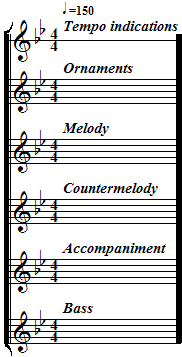
Because of this functional view, my advice is not to use a typical "MIDI editor!" The note/music view of all MIDI editors I know is simply too restricted to be used for arranging. Especially the "piano score view" gives you too few possibilities to write music logically.
The next two steps (3. and 4.) could be combined under the heading "Writing an outline of the arrangement." When both are done, the arrangement is essentially fixed—but it will sound very dull and lack most "kick."
3. Writing the melody notes by ear
Writing down the melody can be easy—or it can be hard.
With the tricks or replacements from step 1. in mind (or sketched down somewhere), you write down the melody. Here are some small pieces of advice for this step:
- If your music editor allows you to insert text, write down any ideas about bass, harmonies, note lengths, or problems you see.
- With a music editor, use repetition marks and other "flow control" signs (D.C. al fine, D.C.al segno etc.): It will save you quite some work in the next steps, as you don't have to copy around bass lines and harmonizations. However, in the last steps, when you add more fine-grained musical expression, you will probably "expand" quite a few of those repetitions. The same is true if you arrange a song which has varying rhythm because of varying syllable counts in the lyrics—also in that case, you will have to copy out and then fine-tune the melody line later.
- If the arrangement is intended for someone to sing along with it, it may make sense to replace e.g. a dotted quarter + eigth with a half+quarter triplet: The precise, counted, "sharp" notated rhythm of a dotted note is usually somewhat eased when singing. However, some songs may lose their character when softened like this (for example, "Quand on n'a pas ce qu'on aime"—not yet on the website).
- Listening very precisely to rhythm is very important for a satsifying sketch of the melody. Usually, when I find that I do not "understand" the rhythm of some stretch of music, I listen to it a dozen or so times, tapping the rhythm on the table. When I know the rhythm by heart, I tap it slower and slower until I can dissect it; at times during this "deceleration," I relisten to it so that I do not introduce my own straightened or otherwise modified beat. After some time, one gets a repertoire of rhythmic elements.
Here is a sample of songs where it took me hours to write down the melody:
- Blue Suede Shoes has a very intricate rhythm with many tiny variations. At the high speed, it is hard to transfer every syncopation from ear to paper. Caring very much for rhythm (as indicated above) was very important here.
- The Allegro from Water Music requires two "choirs:" The trumpets, and the strings. One could think to put the two choirs on two different stops, but there are two problems with this:
- The melodies overlap at many places: Pulling a different stop would therefore break the flow of one or both melodies.
- For small organs (like 20er or 26er), I would not trust the player with manually selecting the right stops fast enough.
Thus, I opted for having the strings in the upper part of the scale, whereas the trumpets are mimicked by lower notes. It took me quite a lot of time to have the two melodies sorted out, but in the end it sounds (arguably) like Handel's original question-and-answer play (actually, there is a third—wood—choir appearing at some places, but I had to merge this with the string choir).
- As a "special case," composing a new piece—like my fantasy on Joy to the World—or part of a piece (an introduction—e.g. to Pomp and Circumstance—, an intermezzo, a coda) also requires to sketch out a new melody. But I won't give you much advice on this (except that you should read Diether de la Motte's book "Wege zum Komponieren").
4. Writing a bass line
When writing a bass line, one has to think about three items:
- The bass line provides the fundamental harmonies for the upper voices.
- On organs without drums (almost all small organs), the bass line also provides the rhythmical foundation.
- Last, a bass line should follow a logical line in itself.
In many (many many!) cases, the bass line will use I-IV-V harmonies. For the 20er scale in the three main major and the three main minor keys, this means that the following bass notes would be used:

It is obvious that using only these bass notes has a few shortcomings, among them:
- In C major, the g for harmonizing V is too far away from the c—it is totally impossible to get item 3. above. Moreover, the g is quite near or even inside the range of melody, counter-melody, or at least accompaniment, so it will probably get "drowned" by one of these voices.
- Even in B major, the e-flat is quite far away from the deeper f used as V.
- In the minor scales (which are, however, rarely used), the g and a also are to near or inside the counter-melody or melody range.
Thus, it is often useful to write the bass with other notes from the respective triads. Here are the standard replacements on the 20er scale for the major keys (with a loose indication of the chord they represent):

With all these notes, bass lines can be made quite a lot more lively. Here is an example:

In some cases, the bass line contains relevant notes. The most prominent examples are the standardized blues and boogie bass lines. Another example is the beginning of Johann Strauß jun.'s "Perpetuum mobile" (which starts roughly like the bass line above). In many cases, such an extensive bass line makes the piece un-arrangable in a small scale. However, if the melody only needs a limited range of the scale, you might be more lucky in writing an extensive bass line. An example arrangement of mine for this is
Boogie Woogie Bugle Boy (this was my first arrangement for 20er scale, in October of 1999). Here is an excerpt from the notated bass (and accompaniment) at the beginning ...

... and somewhere later:

Still, if you listen to the arrangement of "Boogie Woogie Bugle Boy," you might notice that the higher notes of the bass line (above about the f) get "lost" in the accompaniment chords or even the melody line sometimes. The solo bass at the beginning tries to showcase the bass line so that the listener remembers it; or "feels" it when it is repeated a dozen or so times in the complete arrangement.
Of course, a song might require other harmonies: Then, it might be even more difficult to find suitable bass notes from the limited supply in a small scale. Still, the arrangement of Jelly Roll Morton's Shreveport Stomp has (starting at 0:44) a number of harmonies which are not that common on the 20er scale:
D7, Gmin, E7, Amin, Ebmaj, Bb(7)
All scales larger than the 20er (Alderman 26er, German 26er, 31er) are much less restrictive in this respect: There, you can care much more for items 2. and 3.
The bass rhythm of most songs is quite simple: Bass notes occur on the main beat (or beats, in the case of 4/4) in each measure. Together with standard accompaniments, this creates the standard dance rhythms so important in our music: waltz, boogie, march, but also foxtrot, samba etc.etc. If the arrangement should draw attention, this is what one should strive for. On the other hand, if the music can show what it is without need for show, one might arrange freer rhythms: But this is something only you, together with the song to be arranged, can decide. For such a "free arrangement" (actually, most of it is a new composition) you might listen to my arrangement of Joy to the World.
Do I sometimes listen to the music while I write it?
I try not to, for two reasons:
- I want to become more skilled in reading and understanding music directly from a score.
- Listening to the music on the computer is anyway only a bad approximation to the real thing, and sometimes plainly wrong: For example, on playing, the Windows MIDI synthesizer separates two subsequent notes by much more than the 2 milliseconds which NoteWorthy puts between them. Thus, the notes will sound much more legato (and this usually means boring!) on the organ than on the computer!
However, in later steps, when musical expression becomes more and more important, I'll listen to the MIDI and try to imagine how it sounds in the final version. My rationale (or excuse?) for this is that at that time, I am more like a conductor than an arranger: I then try to find what might be called a consistent performance experience, which depends on all parameters of the music played—note lengths (and lengths of breaks), tempo, fullness or even thickness of chords and melodic lines etc.etc. It is, at least for me, not possible to write down all this precisely without listening to it.
5. Harmonizing the melody
This section covers the direct harmonization of the melody, i.e., how to add notes parallel to the melody. In a wider sense, also adding bass, accompaniment, counter-melody, and ornaments can be called "harmonizing the melody"—but these voices are covered in separate sections.
No harmonization
The simplest method, of course, is to use no melody-parallel notes at all. This is perfectly fine and should, in my opinion, be the primary option. Its advantages are:
- Stops can play out their own character. Especially mixed stops (with pipes for fifths and thirds added) have their own character, which is sort of drowned by too much harmonization.
- The limitations of the small scales are not felt as badly. This helps most on the standard 20er and even smaller scales (for example the diatonic 20er scale of the Sankyo movement).
- More notes remain for accompaniment or counter-melody.
Its disadvantages, on the other hand, are:
- The melody might not be loud or prominent enough.
- The song just might require it. For example, I cannot imagine Silent Night without parallel thirds, at least with a more traditional accompaniment.
Harmonization with thirds and sixths
A very common harmonization are parallel thirds and sixths. Here is an example (from a song you probably recogrnize immediately):

On the nearly diatonic 20er scale, one must be careful with parallel thirds in a few cases. Here is the very beginning of "Petersburger Schlittenfahrt" by Richard Eilenberg, with parallel thirds in a chromatic scale:
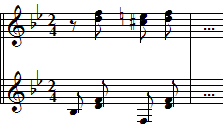
The "obvious," but wrong—or let's say "not so good"—harmonization is the following:

Why is this bad? In the original sequence, all the thirds are minor thirds, i.e. spanning three semitones. Replacing the c-sharp with a c-natural introduces a major third spanning four semitones, which "opens the gap too much;" "pulls down the melody;" simply "sounds strange." It's somewhat hard to describe in words—but the effect is there. As a comparison, here is the better ("correct?") harmonization:

Replacing the minor third with a second (or, if you want, a diminished third) keeps the narrow lines together, without that "opening effect."
Here is a related puzzle: How can you write the parallel thirds in the 20er scale for the following?

Here is the solution:

Using the second (as above) sounds unacceptable for me; using the major third (with c-natural) is in this case a little more acceptable, but still has that "opening effect" explained above. Going back to the b-flat is harmomically correct, because it is the "other note" in the tritonus chord b-flat+c-sharp+e-natural. Two other possible solutions which just crossed my mind are:

The first one drops the idea of parallel thirds for the short scale and uses a single b-flat as a sort of pedal point. The second introduces a small melodic line for the harmonizing notes which "play around" the final d. That melodic line justifies the introduction of the unexpected and quite dissonant minor second e-flat+e.
Harmonization with octaves
This is easy and usually to be avoided, because octaves tend to sound "empty" or "hollow," but also "clear" and "solistic." A famous example of pure octaves is the beginning of the 2nd movement, Andante, of F.J.Haydn's "Surprise Symphony".
I use octaves sparingly; one example is at 1:06 of Quand on n'a pas.
Harmonization with "type chords"
At times, a certain type of music comes with certain chords. Examples are:
- folk music very often uses thirds, sixths, and the dominant seventh.
- Blues and boogie often contain sevenths and ninths.
- Rock often has rasping fifths (in the bass, but also in the melody).
Using these chords can transfer an astonishing "feeling" of some music even on small organs with—for example—only lovely flutes apparently not at all usable for jazz.
Here is an example of extensive use of jazz chords in a 26er (Alderman scale) arrangement of "You made me love you":

As a final note, I would like to stress that correct harmonization is, in my personal opinion, quite important: I hear quite a few 20er arrangements out there which assign harmonies in a somewhat haphazard way to the melody. I would think that the foundations of classical harmonies are still valid today and should be followed; simply assigning V every time the harmony is not clear is not enough.
6. Adding accompaniment
In almost all cases, accompaniment and bass form a sort of single "voice." Thus, one most often starts to sketch the accompaniment together with the bass line.
Still, after writing a trivial accompaniment e.g. for a waltz, one should strive for a logcial and interesting melodic line also here.
Here is an example from Silent Night:

Here is a more simplistic accompaniment:

Although this is of course not "wrong," it is certainly less "interesting" than the one above. Whereas the second follows a simple waltz pattern, the former combines rising triads (b-flat − d − f) with a slightly waltzy feeling.
Just to show you a few other possilbilities, here are two more accompaniments for the same melody. The first one uses jazzy chords with sixth and major sevenths, whereas the last one exhibits trills. Both accompaniments somehow seem to make fun of the simple and famous melody—you must decide whether you want such an impression to be evoked in the listeners' minds:


7. Adding counter-melody
Music becomes interesting when two things happen at the same time:
- The complexity increases;
- There is still a "fabric of understandable patterns" so that the complexity is not perceived as chaos, but as "addition of color."
One standard means of adding such "understandable complexity" is the introduction of a counter-melody—i.e., a second, "low-key" melody played "behind" the main melody. A worthwhile method of introducing such counter-melody is the following:
- Keep the counter-melody at a single note or very few notes while the main melody is show-cased.
- Let the counter-melody do "a little more" when the main melody pauses (usually at the end of a phrase).
Here are some examples from the counter-melody of the 20er arrangement of "Sint Jobs Boogie" (which has originally been composed by Tom Meijer for a larger organ).
The first example shows a counter-melody from the first variation, which is as simple as it can get. It just bridges two breaks in the main melody (originally, these 4 beats are played by drums—also those instruments play "melodies!"; in the following scores, the legato slurs and staccato dots are used as length markers to shorten the notes in NoteWorthy
Composer—see Adjusting note lengths, legato/staccato below for details):

At the end of the variation, there is a counter-melody which is a little more prominent:

Notice how the counter-melody
- exhibits a different "mood" than the main melody: It is legato, lovely, singing;
- uses very few notes.
Together, this introduces a "second personality" into the arrangement, yet, the main melody's character—the restless, forward-pushing boogie rhythm—is not destroyed, just "slightly disturbed."
In the next variation, the counter-melody takes up the fast action of the main melody and tries to play an actual counter-part to the melody (and the bass!):

Finally, at the end of this variation, there are two counter-melodies between the melody and the boogie bass: The upper one continues with the restless triplet rhythm, whereas the lower one again introduces the calmer, tying-together simple singing voice signalling the end of a phrase (although there is one tiny "restless" element also in this counter-melody—can you spot it?):

(The "restless action" in the lower counter-melody is the f, which starts just a bit too early, i.e., "off-beat". A similar effect is used on the final b-flat).
This is, by the way, an example of a 20er arrangement which leads me to the belief that one should strive for "orchestral" arrangements even on this small scale—it is just much more interesting to have this sort of dialog or even "trialog," where various voices try to "tell each other what's going on!"
Up to now, our arranging task was more like a composer's work: We had to find the right notes to produce an interesting rendition of the arranged music. This is now almost finished (if you followed the steps meticulously; actually, you will most probably return later to earlier steps and insert or remove ornaments, accompaniment, or melody harmonization). In the following steps, we take the role of the conductor—i.e., we tell our small "orchestra" how to add more expressiveness to the music—with ornaments; by stressing single notes or chords; and varying the tempo while playing.
From this point on, I listen to the arrangements—first, on the computer; later, I hook up my MIDI-controlled organ and "play back" the arrangement. However, there is one danger with this: One gets "hooked" to the way the arrangement is written, not to some possibly (and probably?) more interesting way of performing. Therefore, it is important to have a rendition of the arrangement in one's mind—before listening to the piece. Here are some suggestions how to get a better rendition:
- Make a printout of the arrangement (or make a copy if you wrote it by hand).
- Let it lie around for at least one day.
- Sing the arrangement—loud or in your head; or whistle it. You should also try this with the bass line, and even the counter-melody and other "interesting phrases."
- Listen carefully where you stress notes; where you shorten notes; where you increase or reduce the tempo; where you insert a short break or fermata—repeat these effects more consciously (that is, more slowly!). If you like an effect, write something in your printout/copy: "Faster here"; "wait a little"—of course, you can also use musical notation.
- Also think about more "overall" effects, e.g.: Should the trio of a march be somewhat faster?—and should the following repetition of the main theme be in the original tempo (to return to the "mood" of the beginning), or should it be somewhat faster (because now it is known to the listener)? You could also play it first with more tempo variation (e.g. have a little fermata on the end of each phrase), afterwards more "straight", more "to the beat". It's all up to you: You must invent some way of "speaking to the listener."
- A good advice is to over-do effects: I, personally, am often to feeble about stressing a note, speeding up a scale, slowing down before an important phrase break. Remember: We live after the romantic age—much of the expressions invented then are still a satisfying part of our life. At least "standard music" should use many of that age's effects.
8. Adding ornaments
Trills and other ornaments help to make music more diverse (some people even believe that
ornaments—especially trills—are the important element of arrangements
for small crank organs). Small organs do not have many stops,
therefore after some time the sound becomes boring. Ornaments help to introduce entertaining elements
into your music. From this follows the first rule of ornaments: Do not repeat ornaments at exactly the same
places throughout a piece: Then you end up with another level of boring music again.
I'll try in the following to sum up a few guidelines and ideas about ornaments—however, I readily
acknowledge that my knowledge only scratches the surface of what can be said about this topic.
The most important ornaments are trills and grace notes. I always write ornaments explicitly in
NoteWorthy Composer, instead of using the tool's "grace note" or other features.
The reason is that I want explicit fine-grained control over each note's duration, also and especially in an ornament,
where tiny changes in tempo (e.g. the triplet at the end of a trill) can change the "feeling" quite a lot.
Trills
A trill has a base or sounding note which is the main note as which the trill is heard.
In almost all cases, the base note is the lower note of the trill—therefore, "trills trill upwards."
A trill usually consists of three parts:
- Possibly, an introductory ornament ("preparation")
- The trill itself ("shake")
- Possibly, an end ornament ("termination")
In general, I like the preparation to be quite slow (slower than the trill) so that it emphasizes the
start of the trill. The preparation is usually played (or at least started) before the beat on which
the trill's base note starts—i.e., it cuts off a piece of the previous note; but this is certainly
dependent on the type of preparation and trill.
The shake is in most cases in triplets—this seems to sound more "irregular" than using
an even division like sixteenths or thirtyseconds.
Here are seven examples of different trills (I wrote this short piece just for the purpose of demonstrating trills):
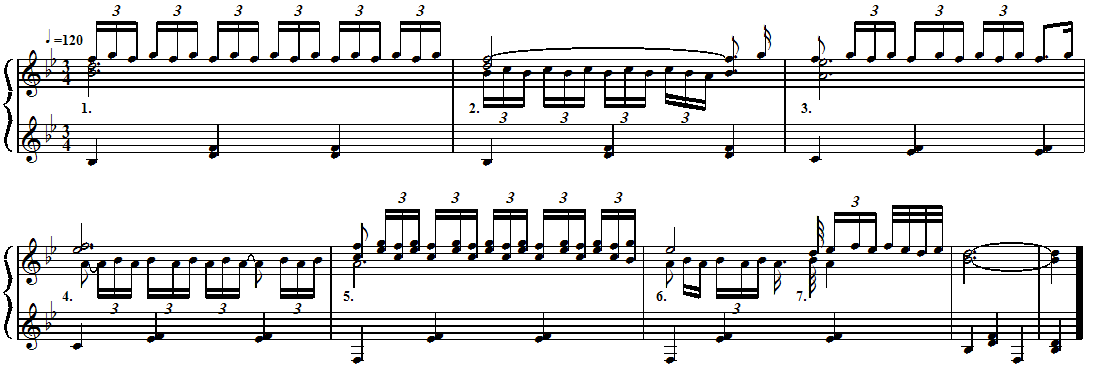
- No preparation, no termination;
- No preparation, simple turn as termination;
- Trill with preparation—a long note (an eighth) with a grave note in the previous measure—and
termination—"fermata" on last note but one;
- A trill which seems to "hold the breath" for a moment (or maybe it ends early, and the last triplet is the preparation of the next trill?);
- A double-voiced trill;
- A short trill;
- Another short trill (or only a turn with preparation?) speeding up in the last notes so that it can connect its turn to the following chord.
When writing a trill, it is best to try to sing it slowly: Then you will get better ideas about where to break, where to speed
up, where to start and where to end the trill and its respective parts.
As a last example, here are two parallel trills with different speeds (this is the very end
of my arrangement of Joy to the World—which is, by the way, full of ornaments in its last third):
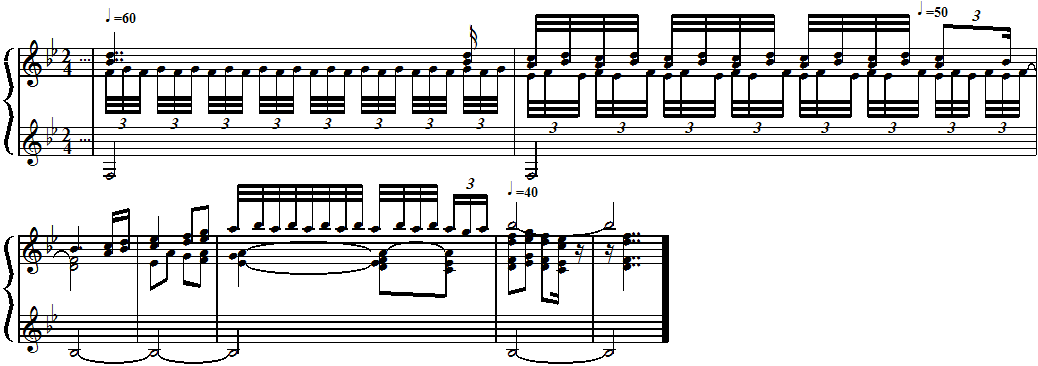
When to use trills? In my opinion, there are two principles you can follow:
- Let trills (and other ornaments) define a part of an arrangement—e.g., a verse of a song. That means that there will trills "at every other corner." In this case, you will put a trill on at most every other long note. Why every other note? In my experience, trills on every long note result in a very boring arrangement. The demonstration piece above is probably the limit of what should be done: Melody and counter-melody each have half of their long notes replaced with trills. You should also vary the trills—add a slow prepartion at later places, a more elaborate termination or the like. An "unexpected non-trill" (e.g. the final long note in the demonstration piece!) might be more interesting than yet another trill.
- Emphasize only a few special places with trills. The most important place here is the dominant chord (V) just before the final chord of a phrase or piece. In this case, a trill works like a "retarding element"—musically, the expected final chord comes "later" because the listener has to deal with the trill first. If you add such a "stress element" in a phrase which is repeated in some way only shortly later, you must put a corresponding ornament at the same place—either the same one, or a more elaborate one. However, "more elaborate" (or "more interesting," "more surprising") can at times also mean that you reduce the "activity" of a trill, maybe even to a non-trill ... oh well, I see I start to contradict myself here. In the end, it all comes down to a "satisfying listening experience," and you and your critics (your listeners) must decide whether you did it "right" or not.
Besides the piece itself, also your customer might have a say in this—as I said, there are people for whom trills are the defining element of small crank organs' music.
Grace notes
A single grace note should sound in the previous beat—i.e., the main note should in general
start sounding right on "its" beat. Thus, prefer (this is from my 26er arrangement of "Plink Plank Plunk")
 to
to 
However, this rule is quite weak. Here is an example (from "Sint Jobs Boogie") where I start a
scale of five grace notes before the beat and end them somewhat after the beat—I think it sounds good:

9. Correcting overlapping and too fast notes
For small crank organs, happily writing notes on many staffs will most probably create two problems at one time or another:
- The same note will sound on different staffs at the same time, but beginning and/or ending at different times. Here is an example—this could be the end of some arrangement in b-flat major:
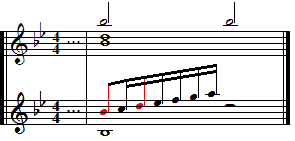
When this music is punched on a roll, the punching machine (or the person drawing the music) will not know when exactly to stop and start the (middle) b-flat and d notes. Such problems must be removed. The punching program I wrote has a special "check mode" which tells me which note in which measure is "started twice." With this information, I can repair the note overlap, e.g. as follows:
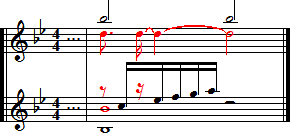
As you can see, the "repair" is not that easy. I once considered to make my punching program "intelligent enough" to figure out such a solution for itself. However, I think it is more correct that the arranger specifies which notes should sound when, than a program using some "rule"—however good it may be.For another example of such a sitation, see the
very end of Trumpet Blues with first a rising and then a falling scale "stumbling through the chords."
- Notes are too short to be punched. On a standard 20er or similar roll, a note requires at least a single hole, with a diameter of around 3mm. For a suitable interval to restart the same note again, another 4mm or so are required as "repetition distance" (so that the valves and pipes can actually stop and restart the sound audibly). Together, this means that the distance between the beginnings of two equal notes must be at least about 7mm divided by 65mm per second, or approximately 1/9th of a second. When arranging, it will happen on and off that note repetitions are shorter than this "technological minimum." A standard experience is for example a trill that is simply too fast; then, you have to slow it down. Another problem is shown below—the 1/32th f cannot be shortened so much that the 1/16th f can start in time (this is again from "Plink Plank Plunk" for 26er):

My punching program will spot also such problems. Here are two possible solutions:
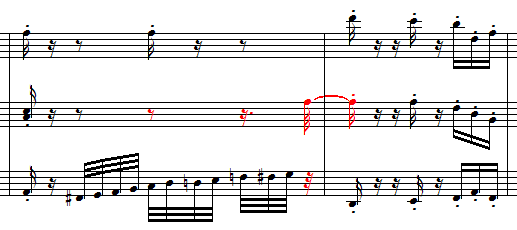 or
or 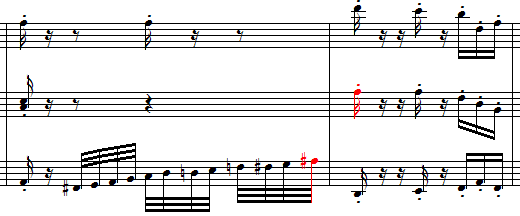
The first one is the standard solution I use at many places: Tying together the notes that are too close for repetition. The problem with this solution is that it introduces an additional "legato feeling," quite often at a place that needs a sparkling staccato on the next note. In such cases, a more radical (more musical) solution must be found—like the second one, which is justified in this case because the f-sharp "pulls up" to the high d and, additionally, to the implied g which is the sixth of the IV'th harmony starting the next measure.
10. Adjusting note lengths, legato and staccato
An arrangement with all the ingredients above—melody and bass and counter-melody and harmonization and ornaments—will still sound duller than it needs to: All notes are bound together legato. But music—all music—is dance music: And dancing never proceeds solely in the flowing, gentle mood of legato. Rather, we have to introduce all sorts of subtle surprises in music expression. Besides the selection of the notes that we hear, the other important ingredient to this is the length of each note (the third one is tempo, which is covered in the following section; a fourth one is volume of each note—but I will not cover this, as small organs, the target of this course, usually have no or only very limited means of changing the volume).
In contrast to pianos and many other instruments, which can use changes in volume to stress notes, organs—at least small ones—stress notes by changing note lengths. The main rule here is:
In order to stress a note, you must shorten the previous note.
Together with the standard rule that the "heavy times" in each measure are to be stressed, this means that the non-heavy ones are to be shortened a little, like in this song from Joh.Strauß jun.'s "Gypsy Baron":

Obviously, it is very much work to write all these dotted notes and small breaks. With NoteWorthy Composer, I use the "legato-staccato" notation which shortens each note roughly by 25% in most cases:

Depending on which notation program you use, you might have to find other shortcuts for specifying typical note shortenings.
For more examples of applying this rule, see the melody voice in the excerpts of "Sint Job's Boogie" above.
In addition to the shortening of non-heavy times, there are a few other "patterns" that should be used:
- In a syncope, the first short note must be shortened to stress the early second note.
- The note before the final note of a phrase can be shortened more than usual.
- The note before an upbeat must be shortened. Here are the additional shortenings in the Strauß song above—the first one only slight, the second one more extreme, because the following two notes start a more important new phrase:

- On the other hand, you might want to remove the shortening of bass or accompaniment notes when the notes in the melody are heavily shortened (or accented): This reduces the "rugged effect" appearing when the notes in all voices are shortened at the same time. Here are three spots where one can apply this—the three red bass notes are now bound legato to the following note and thus "soften up" the interruption in the melody line:

- When you arrange a song with lyrics, the syllables of the text should guide you when shortening notes or not: A syllable with a short vowel justifies a—sometimes extreme—shortening of the corresponding note; a long vowel usually implies tying the note to the next. This has the obvious consequence that, when arranging a piece with multiple verses, you should do the fine-tuning separately for each verse!—but we probably agree that one can also over-do one's "artisticness:" When arranging once more all the stanzas of "Mariechen" or some beer garden song, it is certainly not necessary to invest heavily into thirty-secondth breaks and sixty-fourth delays before heavy times ...
- With scales, one interesting way of stressing is the following (which you can hear from flutists all the time): The first half or so of the scale is legato, towards the end it becomes more and more staccato. The following is the very end of some contract arrangement I wrote:

- Instead of stressing by length, you can also stress with shortness: A staccato note stands out on a line of legato notes. This contradicts the standard rule above—but such is life. Here is an example from the fourth variation of Sint Job's Boogie:

In some cases, you should move the beginning of a note a little instead (or in addition to) its end. The most famous example is the Viennese waltz, where the third beat should be a little bit late (and maybe the second beat a tiny bit early). Here is an arrangement of a Swiss cabaret song I did for a friend in Switzerland:
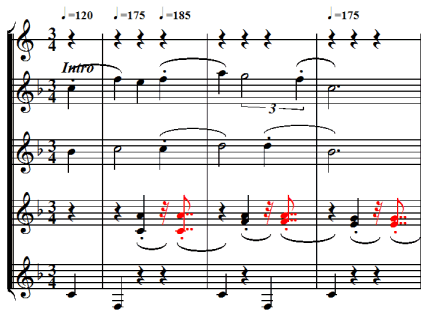
In order to study the effect, you might want to over-do it as follows—but please refrain from this in your arrangements (as opposed to some players at Viennese "Heurigen" who actually play waltzes like this!):

Sometimes, it is also a good idea to pull the beginning of a note into the previous note. One example of this is shown in Listening to it to find the right key for "Music! Music! Music!"
More examples of notes that are moved around less (a sixteenth) or more (an eighth) can be seen and heard in the "cantabile" or trio of "Trumpet Blues And Cantabile." Compare (by playing) the following straight version of the repeated part of the trio with the version in teh actual score (starting at measure 64):

11. Tempo
Music varies in tempo—Boogie Woogie and Rock less than a mellow love song, but at least at the start and end of important parts, suspension is built and un-built by tempo changes.
With crank organs, it is in principle possible to leave the selection of the tempo to the player—who has then at least some chance to interpret the song. For smaller and long-range tempo variations, this is certainly ok. For large tempo changes, or for tempo changes in a short period of time (say less than a measure), it seems more attractive to prescribe the changes by "cutting them into the roll." You must decide yourself whether you want to take the responsibility of tempo change (and therefore take the reponsibility, but also the possibility of deciding for himself or herself from the shoulders of the the organ player) or not.
As with note lengths, it is important that you, the arranger, first have it in your mind how the tempo should change where (and probably also why). You write this with some remarks into your score's copy; and only then do you listen to the arrangement (on the computer or the organ). As a rule of thumb, over-do each tempo change by a factor of two "just to hear what you get." A day later or so, go over the arrangement again to create a "homogeneous listening experience."
There are a few standard rules for tempo changes:
- Start a phrase a little slow; after two to three measures, you can enter the "nominal tempo."
- Also, end a phrase a little slow. The larger the phrase, the more you will decelerate; most prominently, a whole piece will usually end with a quite heavy ritartando.
- When going up in the melody, you can increase the speed a little. When going down, decrease the tempo.
Like the rules for note lengths, also these rule are mere rules of thumb—especially for some interesting effects, you will sometimes want to do the exact opposite ...
Here are two examples of pieces with detailed tempo variations—both are classical pieces, where a fine-grained tempo assignment will make the music more interesting than just "straight playing along." The first one is the beginning of G.F.Händel's Allegro from the Water Music:

The 72-tempo of the first note is just a means of stressing the initial chord very much. From then on, each measure follows essentially the same pattern: It speeds up until the last third—you can feel this pressuring-forward effect with the five eighths quite distinctly; indeed, that's why I introduced it—, then slows again to stress the first beat of the next measure. This sort of tempo changes continues more or less throughout the whole piece, albeit with slightly different tempos all the time (and a few more interesting tempo changes you might want to spot by listening to the whole arrangement!).
The second piece is Johann Strauß jun.'s Pizzicato Polka. Here are the first 19 measures (without the short introduction). Red tempo markers show tempo increases, blue markers tempo decreases (including one breath mark with the duration of a sixteenth note in m.10):
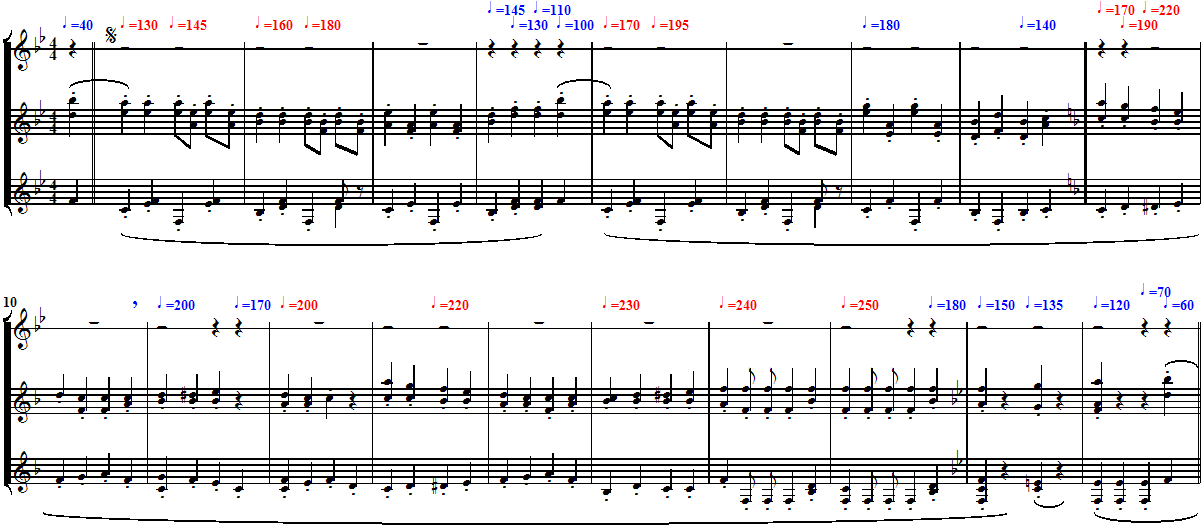
There is a drastic slowdown (from the introduction) to tempo 40 on the first note, building up tension. From then on, each phrase accelerates, but slows down considerably for the next phrase's start. Overall, the tempo increases over the phrases: The first one plays at its end at 180, the next one at 195, then 200 (with an intermediate 220), 200 once more (in measure 12), 220 (measure 14), and finally 250. For the repetition of the main theme, I wanted again the original tempo—and so I slowed down to 150, 120, and finally to 60 (but not the original 40—now, it is no longer interesting to build tension through waiting alone) so that the race can begin once more!
This concludes my little "course on arranging for small crank organs." I hope that you have found something interesting here—if so, but also if you have critical remarks, I'd be happy if you could send me some email:
E-Mail to harald_m_mueller@gmx.de
Home Privacy policy
© 24.7.2022 H.M.Müller






























 to
to 




 or
or 










